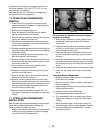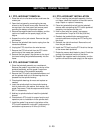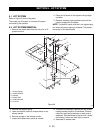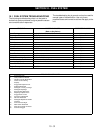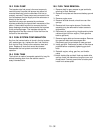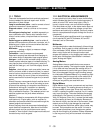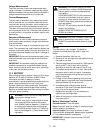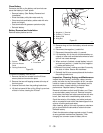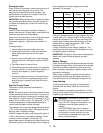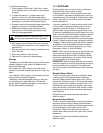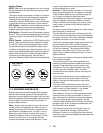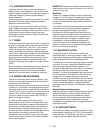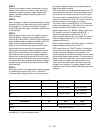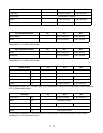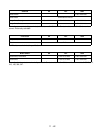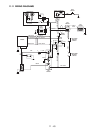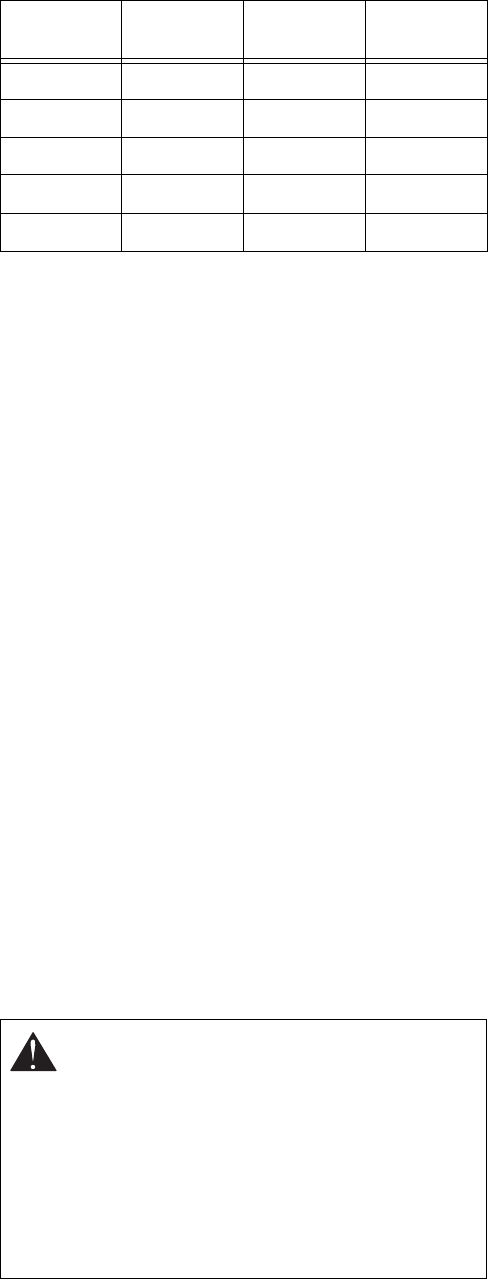
11 - 36
Electrolyte Level
Every 25 hours of operation, check electrolyte level of
each cell by removing caps one at a time. The
electrolyte level should be at level indicated. Use
distilled water to fill each cell if needed. Install and
tighten each cap after checking.
IMPORTANT:
When distilled water is added to battery
during freezing weather, battery must be charged to
mix water with electrolyte, or water will remain at top
and freeze.
Charging
ALWAYS follow information provided on battery by
battery manufacturer. Contact battery manufacturer for
extensive instructions to charge battery.
Place unit on a level surface, shut off engine and open
battery compartment to gain access to battery.
Disconnect negative (-) cable first, then positive (+)
cable.
To charge battery:
1. Loosen strap and remove battery from unit.
2. Place battery on bench or other well ventilated
place where electrolyte spill will not create
damage.
3. Remove caps and fill each cell to level indicated
with electrolyte at 1.230 specific gravity and 80
o
F
(27
o
C).
4. Let battery stand for one half hour.
5. Check electrolyte level and add more if necessary.
6. Connect positive (+) lead of charger to positive (+)
terminal, and negative (-) lead to negative (-)
terminal.
7. Charge the battery at two and a half amps for ten
hours or until all cells are gassing freely and the
specific gravity is constant over three 30 minute
intervals.
Specific Gravity Check
The specific gravity should be checked with a
hydrometer.
NOTE:
The specific gravity should be checked in each
cell and should be the same for all cells. A variation in a
cell reading could be an indication of a problem. Sub-
tract .004 from 1.265 for each 10
o
F below 80
o
F (27
o
C)
or add .004 to 1.265 for each 10
o
F above 80
o
F (27
o
C).
A special temperature compensated hydrometer is
used to read the battery’s state of charge.
The reading on the hydrometer gauge should be above
1.225. If the reading falls below 1.225 specific gravity
there will be an insufficient charge.
ALWAYS charge the battery until the specific gravity of
1.265 is reached over 3 successive readings. Check
monthly to ensure charge is maintained. The
approximate state of charge can be determined by the
cell specific gravity of the rested open circuit voltage at
room temperature and the charging time can be
estimated. For example:
If using an automatic tapering 12 volt charger, choosing
a good quality 5 to 10 amps 15VDC minimum output
charger and charge for 3 to 12 hours according to the
battery state of charge (see table above) or until the
specific gravity in each cell reaches 1.255 - 1.265
specific gravity at 80
o
F (27
o
C).
If using a constant current charger, charge at 1 to 2
amperes for the time given on the table above or until
full specific gravity is reached.
IMPORTANT:
Charging at higher rates will damage the
battery and cause excessive gassing and acid
spewing.
Battery Charger
Under normal conditions the engine alternator will keep
the battery charged. When unit has set for an extended
period of time without operation and the battery has
been completely discharged, a battery charger will be
required for recharging.
Before using a charger, an attempt can be made to
recharge the battery using the engine alternator by
jump starting the unit and allowing the engine to run.
Jump Starting
Jump starting, battery charging, or replacement is
required when the starter motor will not crank the
engine.
The unit used for jump starting should have a 12 volt
battery with at least 500 cold cranking amperes, and a
negatively grounded system.
OCV Specific
Gravity
% of
Charge
Charging
Time
12.60 1.265 100% ---
12.4 1.225 75% 3 hours
12.20 1.180 50% 7 hours
12.00 1.130 25% 10 hours
11.80 1.100 0% 12 hours
WARNING:
FROZEN BATTERIES CAN
EXPLODE and result in death or serious
injury. DO NOT charge a frozen battery. Let
the battery thaw out before putting on a
charger.
UNIT MOVEMENT can result in death or
serious injury. NEVER jump start unit directly
to the starter or starter solenoid. Unit can
move forward or backward and injure the
person jump starting unit.



